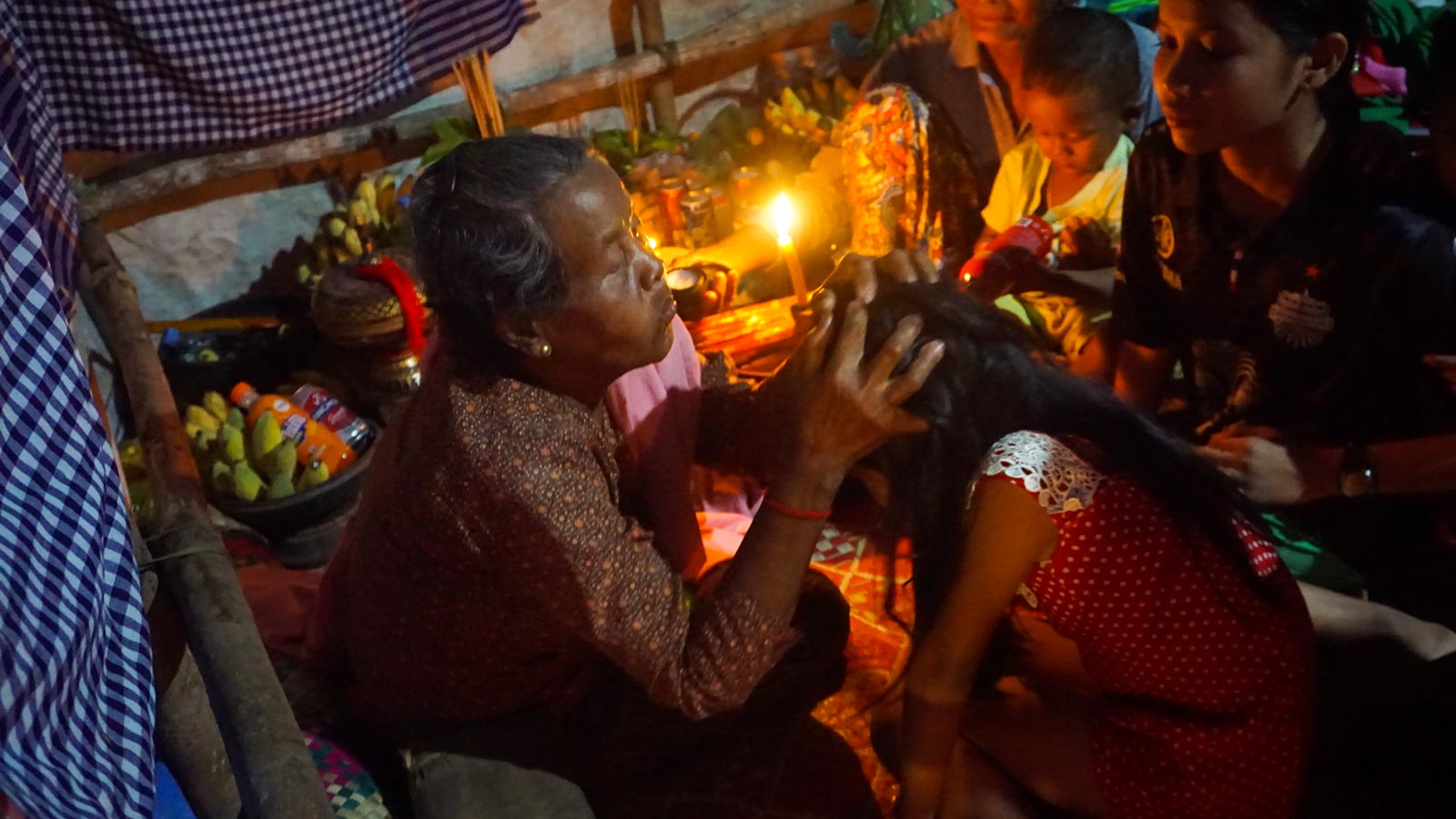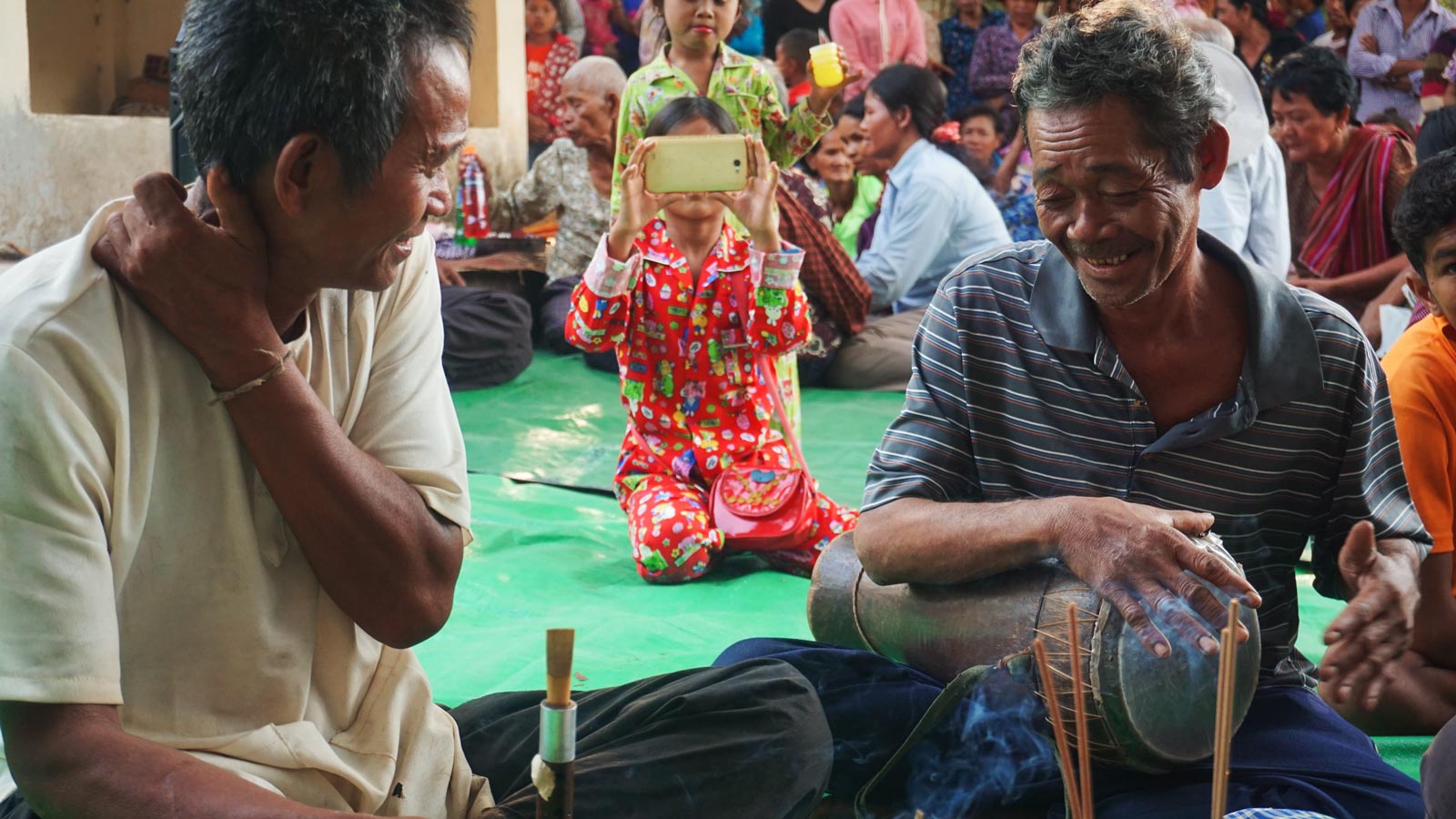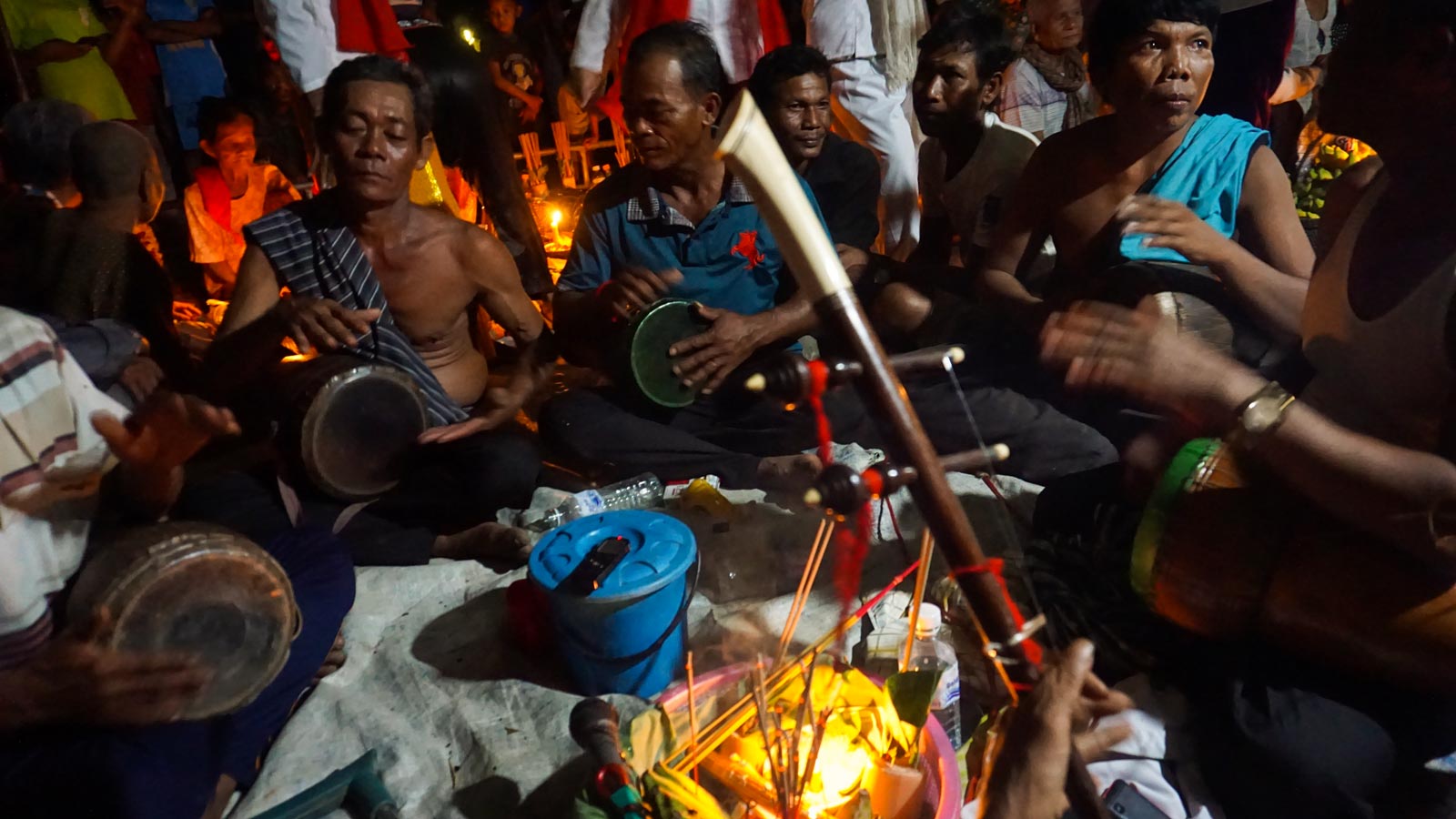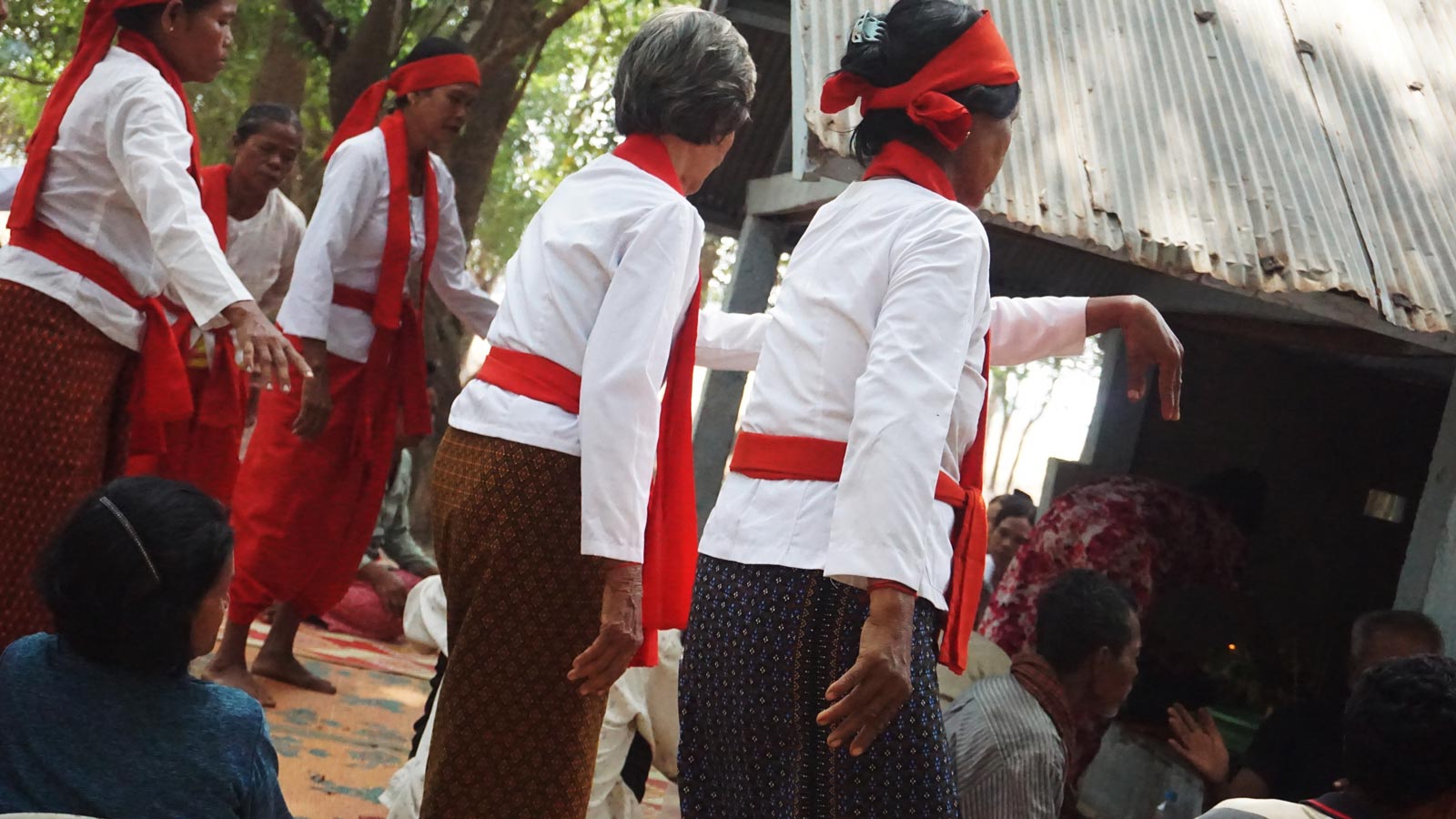“Reamun, reamun ey,” intones the singer in a high, throaty tenor. “Spread your magic. Invite your spirit friends to join us this night.” I’ve heard this song at least once a night for the past week while attending Laeng Neak Ta and Laeng Arak spirit possession ceremonies in rural Cambodia, but it always gives me chills. And Cambodian people tell me there’s good reason for the goosebumps: they are the mark of the spirits called by the music to commune with us mortals for the evening, written in our flesh.
Some spirits are benevolent and some better kept at arms’ length, but none can resist the sounds of pleng arak, or spirit music – so long as the musicians play well, that is. And I have to say that I understand the appeal. For nearly two months, I travelled around Cambodia chasing these sounds – and, with them, the spirits themselves and the mediums that they possess. In doing so, I learned of how people’s spiritual beliefs, musical practices, and ideas about health and healing intersect – and how, in the face of contemporary Cambodia’s rapid development, beliefs and practices are in some cases disappearing, or shifting in complex and fascinating ways.
Pleng arak music serves as a living record of the ways in which Cambodian people for millennia have understood and sought to protect against illness, death, and misfortune in the community. Photo: Emily Howe

Cambodia is alive with spirits – they dwell in rice fields and streams, mountains and caves, temples and homes. Respected and feared, the spirits must be kept happy or they may cause illness or death. Veneration of the spirits is a part of everyday life for many Cambodian people, but there is a special time of year during which the spirits are believed to roam the earth.
That month, khae meak in the Khmer calendar, also corresponds with the end of the harvest season, and Khmer people for millennia have taken this time to thank the spirits for good fortune in the past year, pray for good fortune in the year to come and seek clarity about problems in the community.
They do this by offering music so seductive that the spirits cannot help but join the party. After the possessed mediums dance, the people ask questions about that which plagues them, and work towards solutions meant to appease angry spirits.
I’m an ethnomusicologist, which means that I study how music and sound shape and are shaped by society. I’m particularly interested in how musical practice is wrapped up with broader issues related to development and social change, and pleng arak makes for a fascinating case study. Believed to be the oldest form of Cambodian music continually in use, pleng arak and the indigenous beliefs animating its practice predate more recent Hindu and Buddhist imports and reflect Cambodian people’s deep connections with nature. The music also serves as a living record of the ways in which Cambodian people for millennia have understood and sought to protect against illness, death, and misfortune in the community.
And yet, while the music is traditionally offered to the spirits for their protection or in thanks for healing, the realities of contemporary life, including globalisation, environmental change, and access to medical technology, are affecting the music and the beliefs that underpin it in complex ways – and, some say, could lead to their extinction.

I spoke with Keo Dorivan, a professor of music at the Royal University of Fine Arts who for decades has researched, taught, and performed classical and traditional music in Cambodia. He told me that he used to worry about other forms of Cambodian music dying, but he is less concerned now. The market for the music is consistent thanks to weddings and religious ceremonies, and so performers have incentive to study. Pleng arak, however, is a tougher sell. Why would you visit a kru Khmer traditional healer when you can go to a medical doctor instead? And why would musicians learn repertories and practices for which they can’t get paid?
This is the narrative I’m accustomed to hearing: there is no question that pleng arak will die, it is simply a question of when. And I have certainly spoken with people around Cambodia who tell me that animist practices in their communities are no longer as prevalent as they once were.
And yet, while attending some 20 ceremonies in Kampong Thom, Siem Reap, and Kampot provinces, I was struck by the ongoing pervasiveness of these practices in some areas, and fascinated by the diverse ways in which Cambodian people understand these traditional beliefs in relation to medical practice.
In one community, I watch an angry spirit speak through a medium to berate a man for visiting a medical doctor before looking to him for guidance, surely helping to ensure his ongoing relevance. In another village, a young spirit medium who also works as an administrator in her local hospital explains how she understands traditional beliefs about healing coexisting with medical technology: for her, humans’ veneration of the spirits serves as a sort of insurance policy which can help to prevent against the need for costly medical intervention.

The market for traditional music is consistent thanks to weddings and religious ceremonies, and so performers have incentive to study. Pleng arak, however, is a tougher sell. Photo: Emily Howe
Elsewhere, I speak with a mother who had not previously followed animist practices but who sought out a kru Khmer healer when a medical doctor was not able to help her epileptic daughter. The kru Khmer instructed the woman to make a bargain with the spirits, promising an offering of a pig’s head and pleng arak music should the seizures stop; months later, when the seizures had abated, I attended the ceremony at which the mother upheld her end of the deal and hired musicians to play at three ritual sites.
Meanwhile, the musicians I followed from ceremony to ceremony speak proudly of their ability to make a living from music. “It is not easy to call the spirits,” band leader Ly Mut tells me; his ensemble is well-known for its summoning skills, and receives calls to play at ceremonies all over Cambodia. In another village, a musician brags that he has three wives – a sure mark of economic stability indicating his ability to support multiple households – and another explains that he left his job working on a potato farm in Preah Vihear province for the month of khae meak because it is more lucrative to play with the band.
Proud of their traditional musical knowledge, the musicians also speak openly and pragmatically of changes to their practice. “Now, some spirits like contemporary music,” one tells me simply. And I observe this phenomenon in action: during one ceremony, a possessed medium stands motionless while musicians cycle through songs from the traditional repertoire, eventually demanding a popular song by moving her hands in the wing-like gestures of the saravan folk dance. And the musicians oblige, of course, because their primary intention is not to preserve traditional music; it is to please the spirits. If the spirits want to dance a saravan, so be it.
Across the world, artists and cultural policy workers strive to safeguard music and other forms of intangible culture that, for varied reasons, are at risk of extinction. This often means devising schemes enabling artists to make money from their practice when the market for their knowledge is limited. But institutionalised efforts at preservation sometimes precipitate changes of their own, stultifying living ritual practices in order to present them as “authentic” performance on concert stages or at hotel banquets.
An Raksmey, an anthropologist and technical officer in the Kampong Thom Department of Culture, speaks to the potential risks of performing pleng arak on stage. “The people believe that this music is powerful; it calls the spirits, and some of the spirits are dangerous,” he observes. “If we offer musicians money to perform the music for an audience outside of a ritual context, they may accept, but they may in fact be very unsettled by the experience.”
And so what might a culturally relevant and sustainable attempt at preserving pleng arak look and sound like? Perhaps the challenge for cultural policy in the globalised present is to approach the notion of preservation not only with an ear and eye towards that which has been or may soon be lost, but with the goal of understanding shifting landscapes and soundscapes, and the ways in which practices remain relevant in people’s lives despite or even because of broader societal change.

In the case of pleng arak, this may mean acknowledging that some spirits’ musical tastes are changing. Watching a collection of possessed mediums dance the saravan while a crowd of villagers looks on and laughs appreciatively, it strikes me that may not be such a bad thing. “Sabay, sabay!” one woman shouts joyfully. “Happy.” And with rituals as fun, as meaningful, and as healing as these, it is easy to imagine the practice continuing for millennia to come.
Emily Howe is a PhD Candidate in Ethnomusicology at Boston University. This article is adapted from her forthcoming dissertation, “Animating the Stone: Sound, Embodiment, and the Politics of Development in Contemporary Cambodia.” Learn more about her work at www.emilyhowe.info.


